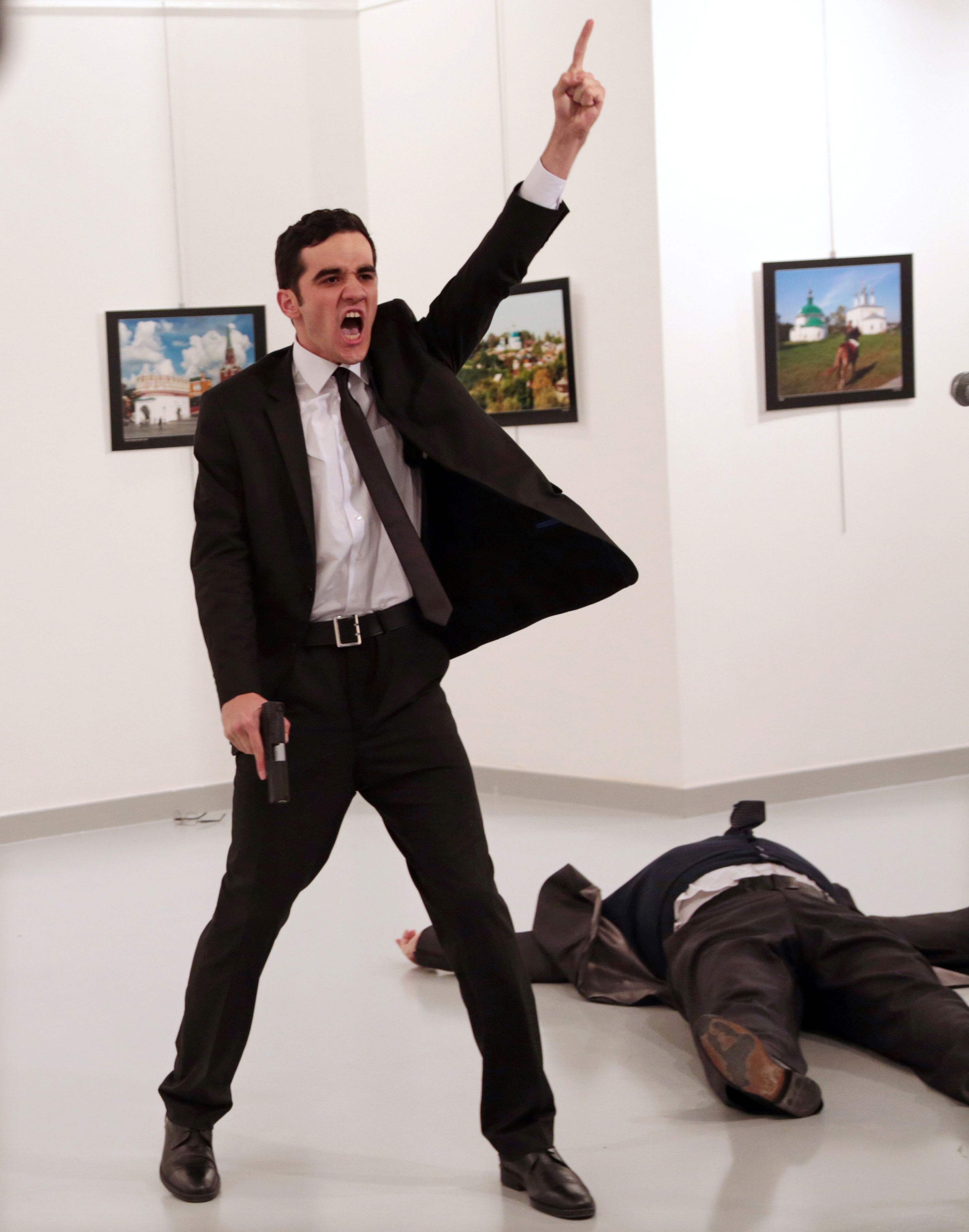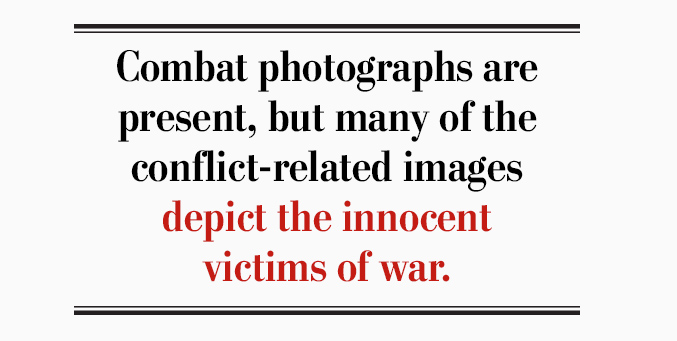
Residents of Mosul flee the city amid fighting between Iraqi forces and the Islamic State in Mosul, Iraq, on Nov. 16, 2016.[© Sergey Ponomarev / The New York Times
For all but two years since 1955, when a shortage of funding shut it down, World Press Photo has been the arbiter of what is best in photojournalism, and what is best has most often been what is worst in humankind.
War, violence, starvation, poverty, cruelty, ignorance and corruption have always been an integral part of the imagery featured in the annual competition, the subsequent exhibition and the book.
Now, as World Press Photo’s annual exhibition begins its Canadian tour at the country’s national war museum, the question remains, more than ever: does it all make any difference?
Many photojournalists have declared themselves anti-war photographers, including 14-time honouree and two-time grand prize-winner James Nachtwey and, before him, Don McCullin, who has been honoured eight times including one grand prize.
Nachtwey and McCullin’s bodies of work, from strife-torn areas all over the world, are incomparable. But there is little empirical evidence they have had any significantly broad or lasting impact, except as icons of the conflicts and tragedies they depict.
They form a part of the record of man’s inhumanity to man and it will be for the historians to decide whether they helped change anything at all.
The early years at World Press Photo were heady days in the industry. Vietnam—the most visual war in history—ruled the 1960s into the 1970s. Iconic photographs, such as Eddie Adams’ Saigon Street Execution, World Press Photo of the Year in 1969, and Nick Ut’s Napalm Girl, winner in 1973, most would agree, helped usher America out of the war in Southeast Asia.
But television, digital photography, the Internet and social media now bombard us with imagery hourly. Hourly. Many people in the developed world have become desensitized by the sheer volume, immune to its impact, or ignore it altogether.

Mevlüt Mert Altıntaş shouts after shooting Russian ambassador Andrei Karlov, at an art gallery in Ankara.[© Burhan Ozbilici / The Associated Press]
The picture stops the viewer in his tracks for a myriad of reasons, not the least of which is the appearance of the terrorist.
Altıntaş, who had just assassinated the ambassador in the middle of a speech, is not one’s ready-made version of a jihadist. He is clean-cut, beardless and looks more like a member of a personal security detail.
Ozbilici, an Associated Press staff photographer, was on his way home after work when he decided to drop by the gallery to check out the opening of an exhibition of Russian photographs. He had no idea what he was in for.
The photographer’s images from that day include a picture of Altıntaş lingering like a spectator behind Karlov as the ambassador addresses those attending the event. Later Ozbilici photographed those same people cowering in corners as the assassin brandishes his weapon.
Altıntaş shouted “Allahu Akbar (God is great)” and later said in Turkish: “Don’t forget Aleppo. Don’t forget Syria.” In a few minutes, he was killed by police, but not before he had brought his message to the world and the Middle East war to Ankara, just as others had to Paris, London, Zurich and Berlin.
Aside from the single picture, the series won the World Press Photo award for spot news stories.
Exhibition curator Sanne Schim van der Loeff says there is no denying the impact of photographs like those of Adams and Ut, but the very same technology that deadens some to their impact today delivers them to a far bigger audience, in every corner of the globe.

“The world has changed, especially when you compare it to the Vietnam War,” Schim van der Loeff said. “The first thing I would say is, look at how many people go to see this exhibition.
“We have, worldwide, around four million people every year, and that’s just seeing the exhibition itself irrespective of people who buy the book and who go online, etc.”
The role of the photojournalist has changed, too, she added. There is no doubt we are constantly bombarded by imagery and information, even to the point of numbness. The curator points out, however, that today’s images have reached a level of nuance, detail and artistic merit that just wasn’t possible 50 years ago.
It’s a testament to photographic skill, no doubt, but also to technical innovation that allows photojournalists to capture images at all hours of the day, in all light conditions, and transmit them from the remotest locations on Earth.
Photojournalism has evolved into an art form. Rather than simply recording what is there in front of them, as courageous as the photographers of yesteryear were, today’s photojournalists are bringing their own style and perspective to picture stories, creating new levels of visibility and understanding.
“In photojournalism today, esthetics has a role to play which I don’t think it had 40 years ago…. Creating that esthetic within an image that hurts also allows you to invite the viewer in and then kind of hit him over the head with the information you want to tell them.”
There are pitfalls. Photo manipulation is easier and more accessible, just as digital cameras have reinvigorated photography itself and invited more amateurs to do the work of professionals.
Two years ago, one in five photographs that made World Press Photo’s penultimate round of judging (22 per cent) were disqualified from competition due to “anomalies” indicative of manipulation. The competition has since required finalists to provide unretouched RAW images for inspection prior to the last round.

Libyan fishermen throw a life jacket to a boat of refugees in November 2016. [© Mathieu Willcocks / MOAS]
They include Canadians Amber Bracken for her work at the pipeline standoff in North Dakota, Giovanni Capriotti for his picture story on a gay men’s rugby club, and Darren Calabrese for his photo essay on limbless athlete Lindsay Hilton.
Combat photographs are present, but many of the conflict-related images depict the innocent victims of war. There is Swedish photographer Magnus Wennman’s photograph of Maha, age five, looking lost as she is comforted by her mother in a refugee camp in northeastern Iraq; Jamal Taraqai’s immediate aftermath of a suicide bombing outside the Civil Hospital in Quetta, Pakistan; Briton Mathieu Willcocks’ photo essay on refugees making the perilous crossing of the Mediterranean Sea, and South African Brent Stirton’s record of the fight to save the black rhino from poachers.
It’s not all dark and depressing, however, and it’s all highly worth seeing. The exhibition is on at the Canadian War Museum through Aug. 13, before travelling to Montreal, Toronto and Chicoutimi, Que.
For more information, see www.worldpressphoto.org/collection/photo/2017.
Advertisement





















